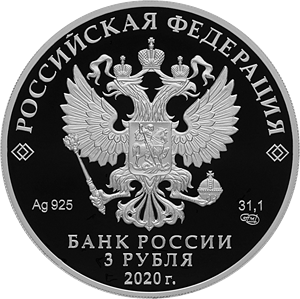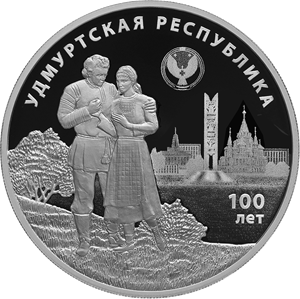Centenary of the Foundation of the Udmurt Republic
Obverse
the mirror field of the disc bears a relief image of the National Coat of Arms of the Russian Federation, over it along the rim there is the semicircular inscription ‘РОССИЙСКАЯ ФЕДЕРАЦИЯ’ (RUSSIAN FEDERATION) framed on both sides by doubled rhombuses, below under the coat of arms there are indications of the precious metal and its fineness on the left and the fine metal content and the mint trade mark on the right, at the bottom in the centre, in three lines, there is an inscription ‘БАНК РОССИИ’ (BANK OF RUSSIA), the denomination of the coin ‘3 РУБЛЯ’ (3 RUBLES), and the year of issue ‘2020 г.’ (2020).
Reverse
the mirror field of the disc bears the following images: the coat of arms of the Udmurt Republic; images of the main building of the Izhevsk arms factory, the monument 'Friendship of Peoples', and St. Michael's Cathedral; a relief image of a young couple in traditional Udmurt costumes standing by the river; along the rim there are inscriptions: ‘УДМУРТСКАЯ РЕСПУБЛИКА’ (THE UDMURT REPUBLIC) at the top and ‘100 ЛЕТ’ (100 YEARS) at the bottom right, written in two lines.
Authors
Designers: E.V. Kramskaya (obverse), A.V. Gnidin (reverse).Sculptors: A.A. Dolgopolova (obverse), A.V. Gnidin (reverse).Mint: Saint Petersburg Mint (СПМД).Edge: 300 corrugations.
Discover more
According to the most ancient archaeological monuments, the territory of Udmurtia was populated during the Mesolithic period (8–5 thousand years BC). In the following archaeological periods, the Western Urals saw a differentiation of the ancient Finno-Ugric people. In early Iron Age (800–300 years BC), the Ananyino culture of the ancestors of the current Udmurts and Komi formed in the Kama River region (Prikamye).
Joining Volga Bulgaria, the first state in Lower Prikamye, in the 10th century caused a significant influence on the ancient Udmurts. Since the 13th century, the Southern Udmurts were under the influence of the Golden Horde and, after that, the Khanate of Kazan. During the Middle Ages, the settlement of Idnakar was the largest centre of craft, cult and administration of the Northern Udmurts who remained independent.
The first Russian settlements were founded on the Vyatka River in the 12–13th centuries. The Northern Udmurtia became a part of the young Russian state. By 1557, after Ivan the Terrible had occupied Kazan, the process of the Udmurts’ joining Russia was completed.
In 1920, the Udmurt Autonomous Region was established. In 1934, it transformed into the Udmurt Autonomous Soviet Socialist Republic and was renamed as the Udmurt Republic in 1991.
The 20th century saw Udmurtia becoming a major military industrial centre of the USSR and Russia owing to its beneficial geopolitical location. Even today, the national structure of state and the military character of the region’s industry heavily shape the historical, social, economic and cultural identity of the Udmurt Republic.
Source: http://www.udmurt.ru


